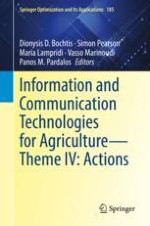This volume is the last (IV) of four under the main themes of Digitizing Agriculture and Information and Communication Technologies (ICT). The four volumes cover rapidly developing processes including Sensors (I), Data (II), Decision (III), and Actions (IV). Volumes are related to ‘digital transformation” within agricultural production and provision systems, and in the context of Smart Farming Technology and Knowledge-based Agriculture. Content spans broadly from data mining and visualization to big data analytics and decision making, alongside with the sustainability aspects stemming from the digital transformation of farming. The four volumes comprise the outcome of the 12th EFITA Congress, also incorporating chapters that originated from select presentations of the Congress.
The focus in this volume is on the directions of Agriculture 4.0 which incorporates the transition to a new era of action in the Agricultural sector, represented by the evolution of digital technologies in 4 aspects: Big Data, Open Data, Internet of Things (IoT), and Cloud Computing. Under the heading of “Action,” 14 Chapters investigate the implementation of cutting-edge technologies on real world applications. It will become apparent to the reader that the penetration of ICT in agriculture can result in several benefits related to the sustainability of the sector and to yield the maximum benefits, successful management is required. The entire discussion highlights the importance of proper education in the adoption of innovative technologies starting with the adaption of educational systems to the new era and moving to the familiarization of farmers to the new technologies.
This book covers topics that relate to the digital transformation of farming. It provides examples and case studies of this transformation from around the world, examines the process of diffusion of digital technologies, and assesses the current and future sustainability aspects of digital agriculture. More specifically, it deals with issues such as:
Challenges and opportunities from the transition to Agriculture 4.0Safety and health in agricultural work automationThe role of digital farming on regional-spatial planningThe enrollment of Social Media in IoT-based agricultureThe role of education in digital agricultureReal-life implementation cases of smart agriculture around the world
